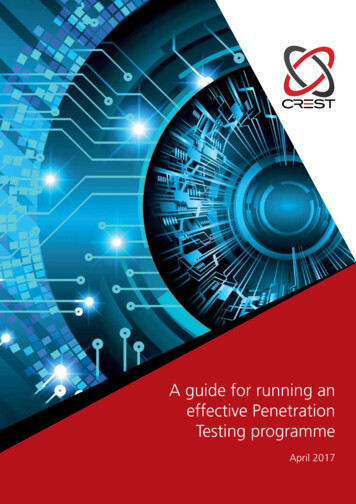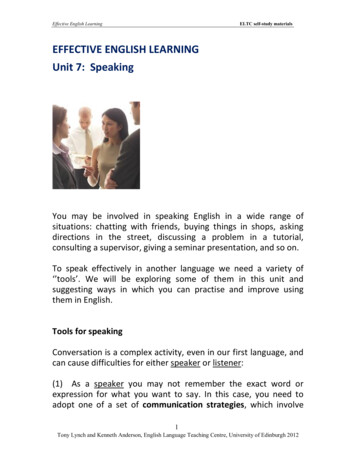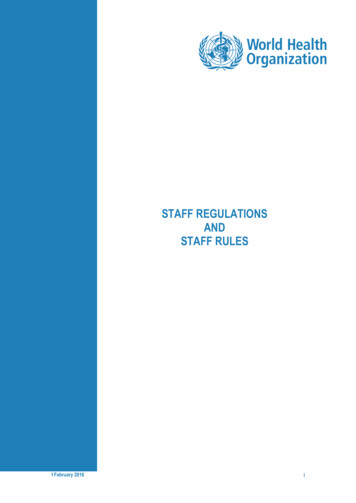
Transcription
A Guide to the Effective Involvement of Children and Young PeopleA Guide toThe Effective Involvement ofChildren and Young PeopleResource PackGo to Chapter
A Guide to the Effective Involvement of Children and Young PeopleWhy are we asking children andyoung people their views?Every child, young person or parent/carer is a member of society. Organisations provide servicesfor people living in that community or society so it’s important that they are consulted andinvolved in the provision of services. Services need to be inclusive, relevant, cost effective, meettheir users needs, improve things, and be accessible. You will be able to check all these things byinvolving children and young people & their families. Althought reference is made to parent andcarers views and involvement, this guide is primarily concerned about the effective involvement ofchildren and young people.Go to ChapterSince the passing of the Children Act in 2004, there has been a growing emphasis on servicesactively involving children, young people and parents/carers in thecommissioning, development and evaluation of services.Increasingly Central and Local Government is interested inmeasuring outcomes rather than focussing on performancemeasures. They want to know about users’ perceptions of theservices they receive and their views on how things can beimproved. Particular attention will be given to how services areimplementing the five Every Child Matters outcomes: Being Healthy Staying Safe Enjoying and Achieving Making a Positive Contribution Achieving Economic Well BeingNEXT2
A Guide to the Effective Involvement of Children and Young PeopleParental participationParents, carers and families play a vital part in the development and delivery of services. Thiswill ensure that a service is developed reflecting local needs and hopes and supports families toaccess the service. Parents and carers are the experts and their child’s primary educator.United Nations Convention on the Rights of the Child.This convention contains 52 standards that set out the Rights of a Child. Most countries includingthe United Kingdom have signed up to the convention. Many countries use the standards whollyor in part to promote children and young people’s involvement. The standards of most relevanceto the participation of service users are:Article 12: Children and young people have the right to say what they think should happen, whenadults are making decisions that affect them, and to have their opinions taken into account.Go to ChapterArticle 13: Children and young people have the right to get and to share information, as long asthe information is not damaging to them or others.Article 17: Children and young people have the right to receive, seek and give information.Article 23: Disabled children and young people have the right to active participation in theircommunity.Article 2: Requires all of the rights in the convention on the Rights of the Child to be implementedfor every child, without discrimination.NEXT3
A Guide to the Effective Involvement of Children and Young PeopleBenefits to participationThe benefits of participation can be seen from two aspects: Benefits for children and young people and parents Success of projects and initiatives develop sustainability.Improved skills and knowledge ranging from practical skills such as presenting ideas, speaking inand to groups, writing and preparing reports, newsletters, letters, posters, negotiation and publicspeaking.Improved confidence, in feeling valued, being of some worth to friends and peers, and feelingsuccessful (not all young people can be academically successful, arty or sporty).Go to Chapter Developing relationships with other children and young people and parents/carers.A feeling of ownership over the services they access.Greater awareness of children and young people’s rights.Greater awareness of participation and decision makingBenefits for projects, organisations and management boards.Improved, better targeted and more effective services for children and young people,and their families.It supports and complements service planning, development and evaluation.Meets user’s needs more effectively.Improved partnership working.Best use of financial resources.Meets government objectives and inspection processes.NEXT4
A Guide to the Effective Involvement of Children and Young PeopleBarriers to ParticipationInvolving children and young people and parents/carers in decision-making makes good sensebut can become difficult for a variety of different reasons. These may include: Go to Chapter Children and young people and parents/carers not wanting to get involved.Lack of staff, resources, motivation or time within your organisation or project to involvechildren and young people and parents/carersCommunication barriers suchas language and culturaldifferences.Lack of skills to listen, andwork with children and youngpeople and parents/carers.Lack of knowledge onsafeguarding and concernsover ethical constraints ofinvolving children and youngpeople and parents/carers.Working flexibly with childrenand young people andparents/carers. Some issuesare: access, time, venues etc.Lack of confidence in knowing how to involve children and young people and parents/carers meaningfully.Lack of awareness of the benefits to be gained.Over enthusiasm by workers who believe they know what is needed and how it shouldbe delivered due to their experience.NEXT5
A Guide to the Effective Involvement of Children and Young PeopleWhat do we want to find out fromchildren and young people?Go to ChapterThe Council need to identify and to be clear exactly what they want to involve children and youngpeople in and the required outcomes.1. Be clear about what you want as a Council, and be open with children and young peopleas to the level of influence that they can expect to have in the services that are provided forthem.2. Once you have set your objectives, consider and experiment with a range of options andmethods.3. Use information to raise awareness and encourage support - do not do anything withoutpublicity within the organisation, and externally if possible4. Try to involve everybody but do not assume that children and young people are ahomogenous group5. Consider what resources your organisation has to offer and how other organisations may beable to support you in terms of staffing, transport, equipment etc.6. Ask young people where and when they want to meet - ask them to advise YOU7. Remember that children and young people have busy lives and develop new interests. Theycan become disillusioned by the time wasted on process and lose interest.9. Take into account children and young people’s previous and current relationships with yourorganisation10. Be prepared for mistakes, acknowledge you are learning and accept criticism11. Acknowledge that initiatives and projects can be established by children and young peoplethemselves12. Feedback to the children or young people you are working with how their information hasimpacted. If you don’t they will be less willing to get involved in the future.NEXT6
A Guide to the Effective Involvement of Children and Young PeopleThe tables below provide a helpful guide and checklist.Children and young people could be involved in a wide range of decisions, for example settingand reviewing policy, recruitment, budget, the environment, local planning etc. Addressingthe following questions will help to ensure that both the process and outcomes are positive. Thislist is not exhaustive but only a start as there are likely to be other considerations linked to thecircumstances of the Local Authority, its demographic and social background affecting childrenand young people.Go to ChapterConsiderWhat are we consulting about?It is important to be clear about the objectives andthe boundaries.By identifying the benefits that you are primarilyinterested in achieving through children’s andyoung people’s participation you will be able toset clear objectives and success criteria on whichto base and evaluate their participation.Involve children and young people in importantdecisions.Whom do we consult?The answer to the ‘what’ question above willinform this, so that children and young people whowill be impacted by the service can contribute toits design.ExampleNew recreational facilities in the community?Sports and leisure opportunities? Places to goand things to do? Improving community cohesionand anti-social behaviour? How to reduce graffitiand litter problems? How to feel safe within thecommunity?All children and young people in the Borough?In a specific part of town? In specific types ofneighbourhoods/schools? Specific groups or ages?NEXT7
A Guide to the Effective Involvement of Children and Young PeopleConsiderAt what stage?This will be informed by the ‘what’ and ‘whom’questions above.Getting this right will impact on the level of childrenand young people’s commitment to the processand the amount of learning they get out of it.Bring them as close to the decision-maker aspossible.Go to ChapterHow much power do childrenand young people have?Set out clearly their role in the decision-makingprocess. Be open about the limits to ideas andrecommendations e.g. how their role relates tothat of others involved in the process.Are there any equal opportunities issues whichneed to be considered?Consider the diversity of those being involved andensure it is representative. The children and youngpeople involved in decision – making must berepresentative – in terms of age, gender, ethnicity,socio-economic background, disability, culture,religion, language or the area in which they live.ExampleIt may not be possible to involve children andyoung people at all stages of the decision-makingprocess. However, as a general rule, it is best toinvolve them as early as possible. The earlier theyget involved, the clearer their understandingof all the issues: required outcome, limitationson outcomes and their own involvement, timerequirements and their rights and responsibilities inthe process.It is crucial to be clear about the level of controlto give to children and young people to see theprocess to the end. Some decisions may requiregreater involvement of adults than others. Soidentify the powers being shared as well as thosebeing completely delegated. Make it clear howeach stage of the decision-making process relatesto the next.Are we talking to children and young peoplewith special needs? Are boys and girls fairlyrepresented? What about children and youngpeople in rural areas? Are we only talking toarticulate youngsters and not enough to the lessvocal, or less motivated? What more can we do toprovide opportunity for all?NEXT8
A Guide to the Effective Involvement of Children and Young PeopleGo to ChapterConsiderWhich method, or combination of methods, is mostappropriate?Select the method carefully to involve hardto-reach groups and the very young. *Involvechildren and young people in choosing themethod where appropriate.ExampleBy offering different kinds of opportunities forparticipation a local authority or school will helpto facilitate and encourage the participation of awide range of children and young peopleThe method used will be partially determined bythe answer to ‘How much power do children andyoung people have?’Who will manage and conduct the process?Involving children and young people in managingthe process will command their trust.Use existing mechanisms, e.g. youth councils/forums, to do this.What resources do we have to do this?Think about budgets and trainingYouth councils/forums? School councils? Webbased intranet surveys? Videos? Questionnaires?Peer-support systems? Voting? Informal workshops?Role play?Make ways of participating relevant to the groupof children and young people.Is it appropriate and necessary for an adult alone,or working with some children and young peopleto be responsible for the process?Consider the financial, material and staff resourcesyou need. Which resources already exist within theauthority? What more is needed? Can we work inpartnership with any other organisations?NEXT9
A Guide to the Effective Involvement of Children and Young PeopleConsiderDo children and young people understand thedecision-making process?If children and young people are to influencedecisions, they need to understand how they aremade.Training for children and young people to enhancetheir participation skills is crucial. All children andyoung people should be able to benefit from thistraining, not just those currently directly involved inoffering their views or representing their peers.Are there any challenges and risks?Consider the organisation’s needs.Go to ChapterWhen?Flexibility is the catchword. Convenience forchildren and young people is important.Use what works best for you.What about feedback?Feedback needs to be timely to avoid childrenand young people becoming disillusioned.ExampleDo the children and young people know who isinvolved in the process? Who has the final say?Who else is being consulted? What procedureshave to be followed?Consider what might go wrong to either delay orstop the process. Establish fall-back plans. Ensurethat children and young people are aware of thechallenges and risks.If planning a one-off consultation, think abouttiming and if it can be combined with anythingelse e.g. local surveys, adult consultations or mockelections during local elections. Consultation neednot happen during school hours or when childrenand young people are likely to be engaged insocial events.Children and young people naturally want toknow how their views have been taken intoaccount, and if not, why not. So identify whathas changed as a direct result of the process andinform them. This needs to be presented in aneasy-to-understand format.NEXT10
A Guide to the Effective Involvement of Children and Young PeopleConsiderWhere do we meet?Consider arranging meetings on children andyoung people’s own territory, or more comfortablesettings for them.Convenience helps the smooth running of theprocess.Is it fun and interesting for children and youngpeople ?Keep a balance between having fun and seriouswork.Go to ChapterWhat rewards for children and young people?Do not assume that because ‘it is good for childrenand young people, there is no need to tell themwhat the rewards are.Are we sharing good practice with otherorganisations?Learn from other people’s mistakes and successes.ExampleAccessibility and transportation in terms ofdistance and mobility/special needs are critical.If meetings are required, consider accompanyingchildren and young people to venues, especiallythose not likely to be familiar with the area.Ensure work is attractive so that children andyoung people can enjoy doing it. If children andyoung people feel they are not being challengedby the process they are likely to lose trust in itsimportance.Why should they be involved, what’s in it for them?For example, sitting on the school council or youthcouncil for the local council contributes to aspectsof citizenship education and can be recordedin a pupils’ Progress Files, or as part of the coursework for the GCSE (Short course) for Citizenshipstudies. The Hear By Right standard recognisesthat alternative types of rewards can be offeredsuch as certificates, good news in local press.There is some excellent work taking place. It isuseful to visit some of the websites identified forsome good practice.NEXT11
A Guide to the Effective Involvement of Children and Young PeopleWho do we want to engage with?Do we want to find out the views of all children and young people?Is there a particular target group such as teenage parents, those from an ethnic minoritybackground, those children and young people with disabilities?Depending on who you want to engage with, in regards to age and ability will depend on thetype of approach to take.Go to ChapterIt is important to understand that a one size fits all approach is not suitable for different age groupsand those who have additional needs. Questionnaires for example may be helpful if you want toobtain a general consensus of opinion with a large group of children and young people but thestyle will need to be adapted. Where more qualitative data is required on a specific topic suchas issues facing teenage parents or those who are in the care of the Local Authority, focus groupsmay be more appropriate.The appendices contain some useful resources which will guide users to effective methods forengaging with different groups of children and young people. This ranges from engaging with: Babies Those with communication difficulties Young children Disabled children and young people Children and young people from different faiths and culturesThe documents within the appendices are a sample of the different guidance that is availableand further information can be obtained from organisations who have particular insight into themost effective methods of involvement for specific groups of children and young people.NEXT12
A Guide to the Effective Involvement of Children and Young PeopleWhen do we want to get theinformation by?The Children and Young People’s Officers Group need to be clear anddevelop a plan detailing the consultation/involvement requirements ofall the different departments within the Council.Go to ChapterThere needs to be at least a 3 month build in time depending on theextent of the required involvement of children and young people.Where the Council wants to develop a questionnaire or survey forexample that is distributed through schools and other communitygroups, time will be needed to develop a questionnaire that is suitableto the different levels of age and ability of children and young people.Although an original draft of the questionnaire can be drafted by anadult, it would be advisable to discuss the wording and the style of thequestionnaire with a group of young people.Thought will also have to be given as to how you want to publicise theopportunity for children and young people to be involved.You will also need to think about school holidays and busy exam timesfor children and young people. Although the school holidays may notbe the best time to obtain quantitative data, with the provision of schoolholiday activities, there may be the opportunity to obtain some valuablequalitative material. But again, staff resources within the Council arelimited and you need to think about whether other agencies couldsupport you in gaining the information that you require.NEXT13
A Guide to the Effective Involvement of Children and Young PeopleOne key question is whether there is the opportunity to link with other organisations and agencieswithin the District or even at a County level. Many organisations need to involve children andyoung people are part of their reviewing and service planning arrangements. There is a dangerover loading children and young people with consultation documents. There is the potential ingaining a greater understanding of the links between different aspects of a young persons’ life.For example, how could the promotion and encouragement of children and young people toparticipate in sporting activities have on their health and emotional well being?Go to ChapterOnce you have obtained the information, you will need to think about how you are going to letchildren and young people know what you have done with the information.NEXT14
A Guide to the Effective Involvement of Children and Young PeopleHow are we going to do it?Involving children and young people in planning participation and consultation events or holdingan event for children and young people requires careful planning. You should consider thefollowing guidelines before the event.All events taking place within an organisation are capable of being planned and deliveredthrough participative methods and sharing the decisions and responsibility of the event itself.Children and young people and parents/carers can be involved right from the idea of an eventitself in terms of:Go to Chapter what would go down well with the “Target” group; when, where, cost, time, making the telephone calls visits to explore possibilities deciding on the event and its promotion: posters, local radio, press, school assembly,word of mouth, selling tickets, etc ensuring any licensing requirements are considered through event delivery: staffing, the evaluation itself - not only of the event but how they have managed and what theyhave learnt for next time because if the adults involved have supported the children andyoung people or parents/carers there will be a next time and probably pressure fromother people to want who become involved and plan their “event”.NEXT15
A Guide to the Effective Involvement of Children and Young PeopleMany organisations/projects or workers are worried about setting up and planning safe events/activities for children and young people and their families. There is no specific guidance thatsuggests one approach will suit all organisations due to the nature and specific group you will beworking with.The Children and Young People’s Officers Group planning the consultation and participationevent/exercise should be clear about the purpose, aims and objectives.They will need to determine: Go to Chapter Methods for involving children and young people in the planning process taking intoconsideration their age, experience and needs of the group, in other words, realisticinvolvement. The attachments contained to this document will provide you withdifferent ideas of how to engage with children and young people. Using non traditionalmethods as well as forums and surveys.Management of the eventMANAGEMENT OF THE EVENTSet up a planning group representing all the interested parties and support. This should includewhere appropriate, young people, staff, community heads, and service providers.There are a number of key challenges that will need to be decided right at the beginning of thediscussion which will include a list of tasks which need to be completed. Encourage lots of ideas.Use post it notes so everyone has a say. Put ideas onto a time line working from the event back to NOW. See the setting up ofthe event as a ‘project’.Group the ideas together such as food, entertainment, stalls, games, paper work. Staffand volunteers can be grouped and take responsibility for an area which intereststhem.NEXT16
A Guide to the Effective Involvement of Children and Young People Go to Chapter Clearly plan your event allocating everyone tasks and deadlines.Publicity for the event - ensure that you include all the details about the event.Ensure you have the right staff for the event.For events you may need to obtain permission to use open space land and/or a licencedepending on the type of event.A risk assessment of the venue should be undertaken.When you know everything that will be happening on the day you should then put allthis detail together in a schedule for the day. This can be given out to inform peopleabout what is happening on the day or for staff to know where and when they will beneeded.At all events a health and safety briefing is important, this can be spoken or written. Atevents you should point out fire and first aid information, toilets, stewards and any otherrules about alcohol or drugs.Documentation and Evaluation for your event must take place. Involve as many peopleas possible, the community, the stall holders and service partners and all those peoplewho have planned and put together the event. This information and documentation willhelp you to improve in the future.NEXT17
A Guide to the Effective Involvement of Children and Young PeopleThe practicalities of the eventThere are 3 main stages:1.It’s about making changes for children and young people Go to Chapter Aims of the session, are they clear?Age of the groupRelevant background of the participantsAny specific needs to be taken into account to aid inclusivity e.g. accessibility, dietary,cultural needsTiming for the session and any breaksThat you and the children/young people are not being used in any way that may bedefined as tokenisticWho is responsible for what?That the children and young people are clear about what they are coming forTransport for children and young peopleExpenses are available in cash if requiredAre the refreshments suitable for children and young people?Can children and young people be involved in the facilitation?Are there enough breaks?Is the methodology appropriate for the age group?Is the time and day appropriate?Children protection procedures and confidentiality levelsIf appropriate, make sure the children and young people are aware of the level ofconfidentialityAny cultural barriers e.g. diet, customsNEXT18
A Guide to the Effective Involvement of Children and Young People2.Venue 3.Go to ChapterThe space available you have to work inIs the venue accessible – what transport will you need, disability access?What equipment do you require – projector, induction loops?Is the venue young person friendly?The layout of the roomIs the room comfortable including adequate heating, lighting and refreshment facilities?Follow up How will the information be fed back and to whom/when?If long term, is the initiative sustainableHow will the process be evaluated?Where will the information go and in what formHow will the young people be able to follow up what happensNEXT19
A Guide to the Effective Involvement of Children and Young PeopleSafeguarding guidance in participation and active involvementThis document should be read in conjunction with the Leicestershire Safeguarding Children andVulnerable Adults Policy of March 2008. That policy contains the broad explanation and dutiesof staff to report any areas of concern relating to the safety and welfare of children and youngpeople.This document provides guidance for staff on how to ensure the safety and welfare of childrenand young people during participation events as based on recommendations from ParticipationNetwork for England.Go to ChapterSafeguarding policies should be used to create an environment where there is no negligence orunnecessary exposure to avoidable risks. Where risks do need to be taken, safeguarding policieswill ensure that they are calculated, carefully managed and communicated to both children,young people, their parents or carers and to paid staff and volunteers. They are not designedto stifle activities, eradicate all spirit of adventure from work programmes, or to replace the trustbetween the people in your organisation with that of suspicion.The following is a practical list of things to consider in helping to plan any event that children andyoung people will be part of.For a residential exercise you might need to look at all the headings but for an evening meetingyou might only use a few. This list is not exhaustive but should provide you with a starting point foryour planning and discussions:(This information to be gained through conversations with the staff at the venue and associatedpaperwork).NEXT20
A Guide to the Effective Involvement of Children and Young People1.Venue Accessibility Fire procedures Additional facilities (is there a prayer room?) Staff resources (do they have a computer or phone lines?) Locks/ security arrangements Risk assessments (ask to see existing ones) Facilities: bedrooms, bathrooms (are they separate for boys and girls?)2.Issues affecting individual children and young peopleYou must obtain this information from a consent form, either completed by the parent or carer ifunder 16 or by the young person.Go to Chapter AllergiesIllnesses/ medical conditionsMedicationDietary requirements (medical/ religious)DisabilitiesEmergency contact detailsKnowledge/ history of the group, relationships, conflictsAbility to swimOther conditions e.g. vertigo, claustrophobiaPermission to take and use photos/ videoEvent timingsNEXT21
A Guide to the Effective Involvement of Children and Young PeopleGo to Chapter3.Activities Does the activity centre have an AALA licence (Adventurous Activities LicensingAuthority)? What insurance arrangements are there? Are all the planned activities available/ possible? Are they appropriate to the group? How much will it cost? Is there a qualified leader? How long will each activity take? Where will they take place? What is the purpose of each activity (learning outcomes?)?4.Transport What method of transport is most appropriate? What is the capacity? What staff ratio is needed when travelling? If using a minibus, is the driver licensed/ MIDAS trained? Is the minibus’s MOT, insurance and breakdown cover up to date? Find this information through the organisation you are hiring a minibus from, or decide ifother transport is more appropriate.NEXT22
A Guide to the Effective Involvement of Children and Young People5.Staff and volunteers you are taking with youNB You may know this information already but if the staff or volunteers are unknown to you andjoining you for this activity, you will need to find out the following: Go to Chapter What will their role be on the activity?What is their experience of residentials?Are they qualified/ sufficiently experienced to lead the activity or take on their assignedrole?Do you have a satisfactory CRB check on them?Have you received and checked satisfactory references for them?Do they have any knowledge of the group?Do you have a designated qualified first aider?Do you have their next of kin/ emergency contact details?Do they have a clear understanding of the organisation’s policies and procedures andhow to implement them? (If not, ensure that they are told where to find them e.g. havea poster/handbook for people not based within the organisation or coming in from adifferent area).6.Undertaking a risk assessmentRisk assessment is an important factor in keeping children and young people sa
A Guide to the Effective Involvement of Children and Young People 2 Go to Chapter Every child, young person or parent/carer is a member of society. Organisations provide services for people living in that community or society so it’s important that they











